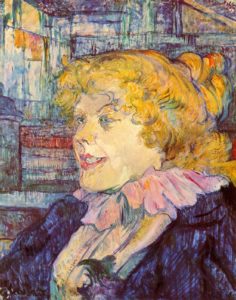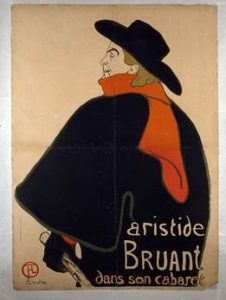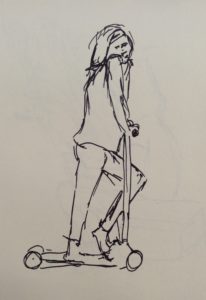
Last week I visited the Toulouse-Lautrec Museum in Albi, a town in the south-west of France and the birthplace of Henri Toulouse-Lautrec (1864-1901). As well as the originals of some of the posters for which he is best remembered, the museum houses many of his paintings and drawings, including some very early ones.
I was impressed by the museum itself and the clear descriptions of the works explained – in English – on the audio-guides. The size of the building and large number of exhibits demonstrated the productivity of the artist. The layout showed his versatility and the range of his skills and I was particularly struck by his superb draughtsmanship.
He died at the age of thirty six.
Toulouse-Lautrec’s drawing skills and also his instinct for dramatic impact is best revealed in the posters he produced advertising Parisian nightclubs. Among those who gave him commissions was Aristide Bruant, a satirical singer with a strong stage personality:
“Following the success of Lautrec’s posters of Aristide Bruant, advertising his performances at two chic Parisian café-concerts the Ambassadeurs and the Eldorado in 1892, the following year Bruant commissioned the artist to create another poster to promote his own cabaret, the Mirliton in  Montmartre. This compelling dramatic work was remarkable for its radical design. Lautrec has reduced his portrait of Bruant almost to abstract forms, with a limited palette of four colours, beginning with a keystone in olive green, then adding black, red and brown. The emphasis is on line and form, creating volume without shading, accentuated by the adoption of flat colours. The image is dominated by Bruant’s signature black cloak and hat, with the incredible slash of the bright red scarf that falls over his shoulder, as he holds the cane that completed his theatrical persona.
Montmartre. This compelling dramatic work was remarkable for its radical design. Lautrec has reduced his portrait of Bruant almost to abstract forms, with a limited palette of four colours, beginning with a keystone in olive green, then adding black, red and brown. The emphasis is on line and form, creating volume without shading, accentuated by the adoption of flat colours. The image is dominated by Bruant’s signature black cloak and hat, with the incredible slash of the bright red scarf that falls over his shoulder, as he holds the cane that completed his theatrical persona.
Also radical is the artist’s choice of viewpoint to depict the singer from behind. Despite the simplicity of the poster, something of the complex nature of Bruant’s character is conveyed, with his face in profile and his features delineated with just a few lines. François Gauzi described this complexity, and saw an analogy with his friend Lautrec’s complicated personality.”
https://nga.gov.au/Exhibition/TOULOUSE
This economy of line and colour is something I have aimed for in some of my quick (5 minute) drawings. Drawing quickly forces me to omit detail and outline the main features. Drawing in ink prevents me form fussiness over getting positions and proportions too exact. I think the results are more real than more detailed studies.
_____________________________________________________________________


